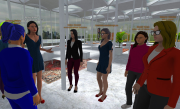Could the stereotype of academics standing in front of a chalkboard be replaced by virtual reality? In light of worldwide event cancellations, scientists are rethinking how they network. Today, researchers are turning to online platforms as a way to connect with researchers and journalists around the globe. Here, Luciana Löberg, events manager for the Graphene Flagship, explores the future of virtual conferences and their potential to offer wider accessibility.
Hundreds of academic conferences have either been cancelled or postponed this year. As more events are expected to follow suit, the future of scientific conferences is set to change.
Meetings and conferences in academia are significant for a number of reasons. One is that — along with peer-reviewed journals and media outlets — they are an effective way of sharing ideas with fellow academics and thinkers from around the globe.
For example, Graphene Week 2019, Europe’s leading conference for graphene research, was an opportunity to release plans for the Graphene Flagship’s upcoming industry-led Spearhead Projects. This included presentations on the impressive uses of graphene for scientific achievements in such diverse sectors as energy, aviation, aerospace and automotive. It was possible to present this breadth of information, to a receptive audience, thanks to the platform that scientific conferences provide.
The current spate of event cancellations could therefore significantly impact the quality and reach of ongoing scientific projects. After all, there is little use in scientific knowledge and applications if they cannot be communicated effectively to others.
That’s why academics need an alternative. Fortunately, virtual conferences might hold the key.
There in spirit
We’re all familiar with video conference calls. But can you imagine a conference that transfers this idea into a three dimensional (3D) virtual world? That’s exactly what happened at the world’s first virtual scientific conference for Women in Graphene, held by the Graphene Flagship on March 18 to 19 — just ten days after International Women’s Day on March 8.
The Women in Graphene conference has previously been held at partner institutions around Europe. The annual event was first launched in 2015 to give female researchers the opportunity to discuss their research, while also inspiring more women to become involved in science — particularly in fields relating to graphene and layered materials.
In response to the COVID-19 crisis, this year’s conference stepped into a new arena — a virtual one. Hosted through an online conference platform, the event provided a virtual venue within the kind of 3D environment more typically seen in a video game. Researchers that attended the conference were encouraged to interact with each other through their own chosen 3D avatars, while attending three different lecture halls and networking lounges. As with a real-life conference, representatives from the Graphene Flagship were also on-hand to meet and greet attendees during the two-day virtual event.
Sounds novel, doesn’t it? In fact, the virtual set up enabled the Graphene Flagship to host the most successful and diverse Women in Graphene event since the scheme’s inception.
Continued lockdowns worldwide did little to affect the pedigree of the conference’s keynote speakers, and this year’s event attracted distinguished speakers from several Graphene Flagship partners. They included Italy’s Consiglio Nazionale delle Ricerche (CNR), or National Research Council, The Catalan Institute of Nanoscience and Nanotechnology (ICN2) of Spain, and the University of Manchester, UK, along with other leading institutions. On top of that, Laura Kennington, endurance athlete and inspirational speaker, delivered a motivational lecture.
Attendees also enjoyed a useful training session on negotiation skills from Dr Sue Hewitt of the Springboard Consultancy, which specialises in development courses. Each speaker was able to participate freely in the event, undeterred by travel restrictions.
In fact, looking to the future of scientific conferences, increased remote working is likely to improve the quality and variety of speakers at events. After all, delivering a keynote from the comfort of your own home requires far less investment than the time, travel and other resources that are usually required to take part.
Accessible to all?
Women in Graphene wasn’t the only event to be held virtually this year. Other events have seen not only stability, but significant growth.
While Women in Graphene’s 2020 visitor levels were in-line with previous years’ events — around 70 people — the decision to “go virtual” also drew a wider attendance, including some researchers from India. However, the broader attendance for these virtual events also raises questions about the accessibility of real-life conferences. Due to physical mobility constraints, financial limitations and family concerns, the fact remains that academic conferences are not easily accessed by everyone.
Recently, researchers surveyed more than 60 academics with a disability. The findings identified several issues of accessibility at conferences, which included access to the conference venue itself, plus other factors like distance from the airport and wheelchair accessibility at local hotels.
Virtual conferences can, of course, eliminate these issues altogether. Another significant advantage for attendees is cost, as several conferences have reduced their fees for attending online.
It remains to be seen whether virtual conferences replace the old tradition of academics standing in front of a chalkboard together. Nevertheless, the advantages of virtual conferencing — and disruptions to “traditional ways” of doing things — are already impossible to ignore. It’s clear that, even in conjunction with real-world conferences, the online world holds many benefits that could make the latest academic ideas accessible, and enlightening, for all.
